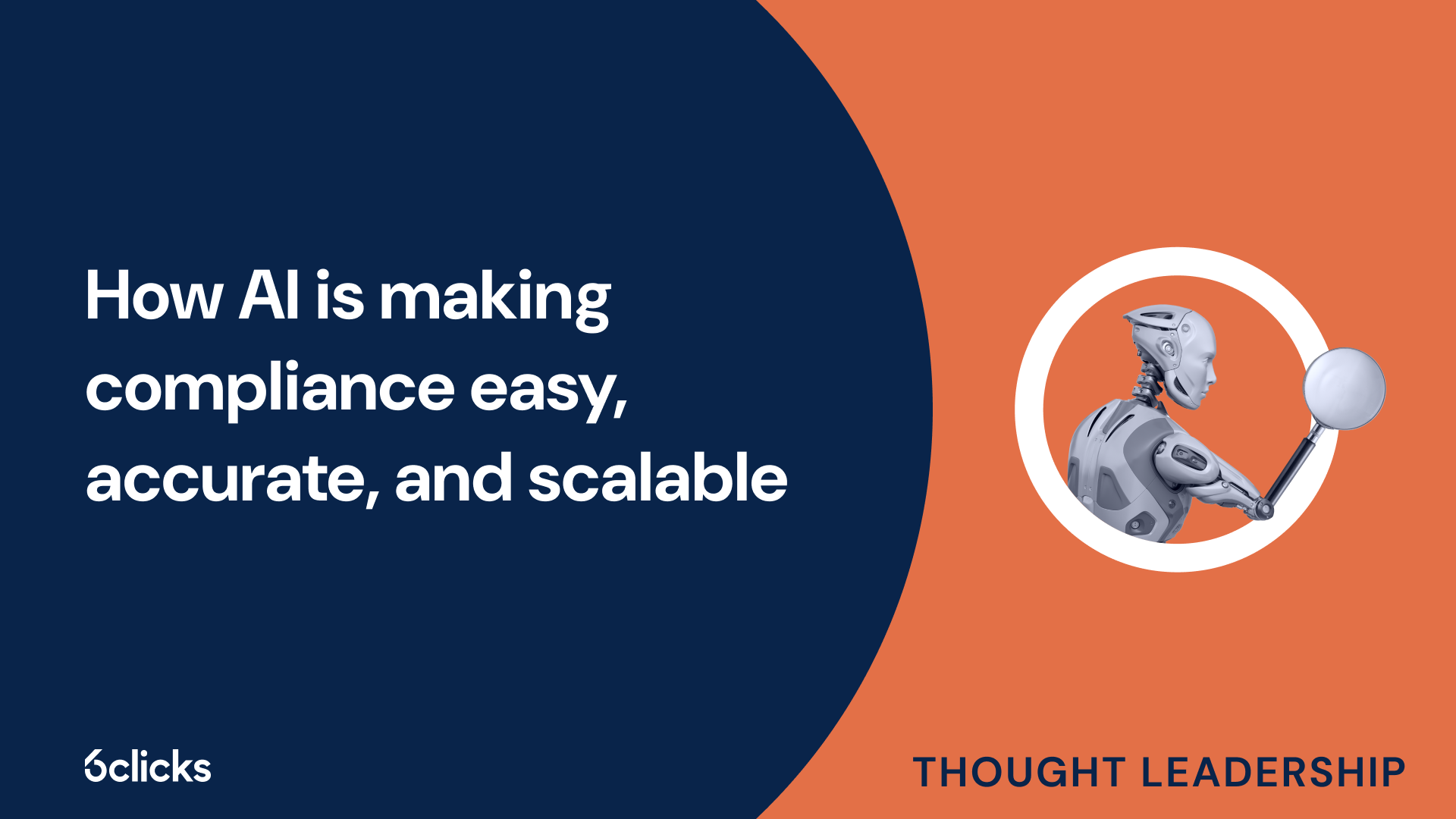How to get DISP membership fast
Discover how to get DISP membership fast with this free, step-by-step guide for Australian defence contractors. Learn about DISP requirements, membership levels, application tips, and how 6clicks helps accelerate compliance across security domains.
-1.png?width=200&height=249&name=Group%20193%20(1)-1.png)
How to get DISP membership fast
What is security clearance?
Security clearance refers to the process of determining an individual's suitability to access classified or sensitive information. It is a crucial aspect of national security and is conducted to ensure that only trustworthy and reliable individuals are given access to sensitive government information. The process involves a comprehensive background check, including a review of personal, criminal, and financial history, as well as an evaluation of any potential risks or vulnerabilities. Security clearance is typically given in different levels, depending on the nature of the information to be accessed and the responsibilities of the individual. In Australia, there are five main levels of security clearance, each with its own requirements and vetting process. These levels range from Baseline Vetting to Top Secret Positive Vetting, with each level granting access to a progressively higher degree of classified information. The goal of security clearance is to ensure the protection of national interests, while also maintaining the confidentiality and integrity of sensitive government information.
What are the levels of security clearance in australia?
Australia has five levels of security clearance, which determine the level of access individuals have to classified resources. These levels are Baseline, Negative Vetting Level 1 (NV1), Negative Vetting Level 2 (NV2), Positive Vetting (PV), and Positive Vetting with Additional Vetting (PVA).
The Baseline clearance is the most basic level and is required for individuals to access protected resources. It includes checks of an individual's criminal history and their Australian citizenship status.
The NV1 clearance is the first level of higher clearance and involves a thorough background investigation to determine an individual's suitability for accessing classified resources. This level allows access to confidential and secret resources.
The NV2 clearance is the second level of higher clearance and involves additional checks beyond NV1. Individuals with NV2 clearance can access top-secret resources.
The PV clearance is the highest level of security clearance in Australia. It involves an in-depth background investigation, including interviews and reference checks. Those with PV clearance can access all classified resources.
Finally, the PVA clearance is an enhanced version of PV clearance that involves additional vetting due to specific job requirements or sensitive roles.
Each level of security clearance provides individuals with progressively higher access to classified resources, ensuring that only those with the appropriate level of trust and responsibility can handle sensitive information.
Level 1 – confidential clearance
Confidential clearance is the first level of security clearance in Australia, allowing individuals access to confidential resources. It is a crucial step in ensuring the protection of sensitive information and maintaining national security within government agencies. Obtaining this clearance requires a thorough background investigation, including checks of an individual's criminal history and Australian citizenship status. The aim of this level is to assess an individual's trustworthiness and reliability to handle confidential information appropriately. With confidential clearance, individuals can access and work with classified resources that are deemed confidential in nature. While it is the entry-level clearance, it plays a vital role in enabling individuals to contribute to government organizations and carry out their designated tasks. By establishing a baseline standard of security, the confidential clearance ensures that only authorized personnel have access to confidential information and contributes to the overall security framework of the Australian government.
Who is eligible for level 1 clearance?
Level 1 security clearance in Australia is the most basic level of clearance required to access classified information or work on projects involving national security. To be considered eligible for level 1 clearance, individuals must meet certain criteria.
The eligibility criteria for level 1 security clearance require individuals to be Australian citizens with a clean criminal record. It is also essential that applicants demonstrate a responsible and trustworthy nature with a strong commitment to upholding the confidentiality of classified information.
In addition, individuals applying for level 1 clearance must successfully undergo a comprehensive background check. This involves verifying personal and employment history, as well as conducting character references and financial background checks.
To ensure the utmost security and suitability for clearance, applicants may also be required to undergo a psychological evaluation or drug and alcohol testing.
It is important to note that level 1 clearance is just the first level of security clearance in Australia, and there are additional levels that require higher levels of scrutiny and background investigation.
By meeting the eligibility criteria for level 1 clearance, individuals can begin their journey towards obtaining higher security clearances and taking on more sensitive roles within government agencies and organizations dealing with national security.
What are the requirements for level 1 clearance?
Level 1 security clearance in Australia requires individuals to meet specific requirements to access classified information and contribute to projects involving national security. To obtain level 1 clearance, applicants must be Australian citizens and possess a clean criminal record. Demonstrating responsibility and trustworthiness is crucial, along with a strong commitment to maintaining the confidentiality of classified information.
Applicants for level 1 clearance will also undergo a comprehensive background check. This process involves verifying personal and employment history, conducting character references, and examining financial backgrounds. Additionally, applicants may be subjected to psychological evaluations and drug and alcohol testing to ensure security and suitability for clearance.
Level 1 clearance grants access to classified resources that are considered low-risk to national security. While these resources may contain sensitive information, the potential damage to national security is relatively low compared to higher-level clearances. It is important to note that level 1 clearance is just the beginning stage of security clearance in Australia, and there are additional levels that require more detailed scrutiny and background investigation.
How long does it take to get a level 1 clearance?
The processing time for obtaining a level 1 security clearance in Australia is targeted at 20 working days, according to the Australian Government Security Vetting Agency (AGSVA). AGSVA is responsible for conducting background checks and vetting processes for government agencies and individuals seeking security clearances.
During the clearance process, applicants for level 1 clearance undergo a comprehensive background check, which includes verifying personal and employment history, conducting character references, and examining financial backgrounds. Additionally, psychological evaluations and drug and alcohol testing may be conducted to ensure security and suitability for clearance.
To ensure efficiency and accuracy, AGSVA aims to complete the level 1 clearance processing within 20 working days. However, individual circumstances and complexities of the case may impact the processing time. It is important for applicants to provide all necessary information and cooperate fully with AGSVA to facilitate a timely clearance process.
Obtaining a level 1 clearance is an essential step for individuals wishing to work or gain access to classified information within the Australian government. The timely completion of the processing helps ensure the security of the nation's classified material and the trustworthiness of the individuals who hold the clearance.
What Are the benefits of getting a level 1 clearance?
Obtaining a Level 1 security clearance in Australia offers numerous benefits for individuals seeking to contribute to national security and excel in their respective fields. With a Level 1 clearance, individuals gain access to confidential classified resources, allowing them to handle protected information and contribute to vital projects and operations.
One of the key benefits of holding a Level 1 clearance is the increased career opportunities it presents. Many government agencies and organizations require individuals with a security clearance to handle sensitive information and perform certain roles. By obtaining a Level 1 clearance, individuals become eligible for these positions, opening up a wider range of career prospects in the government sector.
Additionally, individuals with a Level 1 clearance gain trust and credibility among their peers and superiors. The rigorous security clearance process demonstrates a commitment to upholding the highest standards of integrity and loyalty. Employers value these qualities and prioritize individuals with a Level 1 clearance due to the trust placed in them to safeguard sensitive information.
Furthermore, a Level 1 security clearance allows individuals to actively contribute to national security efforts. By having access to classified resources, individuals can effectively perform their job responsibilities, conduct comprehensive research, and collaborate with professionals in the field. This level of involvement allows individuals to make meaningful contributions to safeguarding Australia's security interests.
Level 2 – secret clearance
Level 2 security clearance, also known as secret clearance, builds upon the foundation of Level 1 clearance by granting individuals access to more classified information. This increased level of clearance comes with added responsibility and trust from employers and the government. With a secret clearance, individuals can pursue even more advanced career opportunities in government agencies and organizations that deal with sensitive and confidential information. This level of clearance allows individuals to play a crucial role in protecting national security interests and contribute to important initiatives and projects. By holding a Level 2 security clearance, individuals demonstrate their commitment to maintaining the highest standards of integrity, trustworthiness, and discretion in handling classified resources and information.
Who is eligible for level 2 clearance?
In Australia, Level 2 clearance, also known as Secret Clearance, is a security level granted to individuals who require access to classified information up to and including the Secret level. To be eligible for Level 2 clearance, applicants must be Australian citizens and have lived in Australia for at least the previous 10 years.
The eligibility requirements for Level 2 clearance involve a stringent background check. This includes a comprehensive assessment of an individual's personal, professional, and criminal history. The background investigation considers factors such as financial history, credit checks, and any potential foreign influence.
It is important to note that obtaining Level 2 clearance does not automatically grant access to all classified information. Different levels of clearance, such as Negative Vetting Level 1 and Level 3 security clearances, are required for accessing higher levels of classified material.
Negative Vetting Level 1 (NV1) clearance is the baseline security requirement for Australian government employees and contractors whose duties require access to classified information up to and including Protected level. On the other hand, Negative Vetting Level 3 (NV3) is the highest level of security clearance granted to individuals who require access to highly classified information.
What are the requirements for level 2 clearance?
Level 2 clearance, also known as Secret Clearance, in Australia has specific requirements that individuals must meet to be eligible. To obtain level 2 clearance, applicants must be Australian citizens and have resided in Australia for at least the past 10 years.
The eligibility criteria for level 2 clearance include a comprehensive background check that examines an individual's personal, professional, and criminal history. This investigation considers factors such as financial history, credit checks, and any potential foreign influence.
It is important to note that level 2 clearance does not automatically grant access to all classified information. The level of clearance determines the type of classified resources an individual can access. While level 2 clearance allows access to classified information up to and including the Secret level, higher levels of classified material require different levels of clearance, such as Negative Vetting Level 1 (NV1) or Level 3 (NV3) clearances.
In addition to the thorough background check, additional checks and investigations may be required for level 2 clearance, depending on the nature and sensitivity of the classified information involved. These checks ensure the security and integrity of the clearance process and prevent unauthorized disclosure.
How long does it take to get a level 2 clearance?
The processing time for obtaining a Level 2 clearance in Australia can vary depending on several factors. On average, it takes approximately 3 to 6 months to complete the clearance process.
There are several factors that may affect the processing time for Level 2 clearance. Firstly, the complexity and completeness of the individual's background check and vetting process can impact the timeframe. If there are any discrepancies or issues that require additional investigation, it can prolong the clearance process.
The workload of the relevant government agencies or departments responsible for processing security clearances can also affect the timeframe. Higher volumes of clearance requests or a backlog of cases can result in delays.
Additionally, any necessary interviews, meetings, or consultations with referees or other individuals who can provide relevant information may contribute to the processing time.
It is important to note that these factors can vary in each individual case, and the processing time may be faster or slower depending on the circumstances. It is always recommended to submit clearance applications well in advance to allow enough time for processing.
What are the benefits of getting a level 2 clearance?
Obtaining a Level 2 security clearance in Australia offers numerous benefits to individuals in terms of job opportunities and career advancement. This clearance level grants access to classified resources, including TOP SECRET information, which is the highest level of classified information in the Australian government.
The benefits of having a Level 2 clearance are twofold. First, individuals with this clearance level can access a wide range of classified materials that are essential for performing their duties effectively. This access to sensitive information enables them to contribute significantly to their organization's objectives and national security efforts.
Second, having a Level 2 clearance opens up new job opportunities and the potential for career advancement. Many government agencies and organizations, including the defense and intelligence sectors, seek individuals with the appropriate security clearance for roles that involve handling classified information. Individuals with Level 2 clearance are highly sought after for these positions, as they have already undergone a thorough background investigation and demonstrated trustworthiness.
Moreover, individuals with a Level 2 clearance have a competitive edge over others in the job market, as their clearance status shows their eligibility for access to classified resources. This can lead to better career prospects, increased job stability, and opportunities for professional growth within the government and defense sectors.
Level 3 – top secret/secure area access (SAA) clearances
Level 3 - Top Secret/Secure Area Access (SAA) clearances provide individuals with the highest level of security clearance in Australia. This level is reserved for individuals who require access to highly classified information and resources crucial to national security. The Level 3 clearance involves a rigorous vetting process that includes comprehensive background checks, extensive financial history and credit checks, as well as assessment of potential foreign influence and unauthorized disclosure risks. This level of clearance grants individuals access to top-secret information and requires them to undergo additional checks and training. Individuals with a Level 3 clearance have unparalleled opportunities for career advancement and are sought after by government agencies and organizations working in sensitive sectors. This level of clearance denotes the highest level of trust and reliability, and individuals with Level 3 clearance play a crucial role in safeguarding national security information.
Who is eligible for level 3 SAA clearance?
Level 3 SAA clearance, also known as Secret Positive Vet (SPV), is a security clearance level in Australia. To be eligible for Level 3 SAA clearance, individuals must meet certain criteria. These criteria typically include Australian citizenship, a satisfactory background check, and employment within government agencies or organizations that deal with classified material.
Level 3 SAA clearance allows individuals access to a higher level of classified information and resources. At this clearance level, individuals may have access to sensitive information that is critical for national security. This clearance level demonstrates a higher level of trust and responsibility.
The security level of accessible resources at Level 3 SAA clearance is significant. It is meant for individuals who are entrusted with important and classified documents, ensuring that only authorized personnel have access to such sensitive information. The eligibility criteria for Level 3 SAA clearance aim to ensure that individuals with this level of clearance uphold the highest standards of security and integrity in order to protect national interests.
What are the requirements for level 3 SAA clearance?
The requirements for obtaining a Level 3 Secure Area Access (SAA) clearance in Australia are stringent and thorough. Individuals seeking this clearance level must go through a rigorous vetting and background check process conducted by the Australian Government Security Vetting Agency.
To qualify for Level 3 SAA clearance, applicants must be Australian citizens and must have been a resident in the country for the past 10 years. They must possess a demonstrated loyalty to Australia and a commitment to upholding national security.
Level 3 SAA clearance provides access to classified information at different classification levels, including Protected, Confidential, Secret, and Top Secret. These levels determine the sensitivity of the information, with Top Secret being the highest level of classified information.
With Level 3 SAA clearance, individuals can access sensitive and critical resources necessary for national security. This clearance level demonstrates a high level of trust and responsibility, and clearance holders must adhere to strict protocols to ensure the protection of classified information.
Learn about how 6clicks can help with your DISP compliance and membership and ASD ISM & IRAP assessments and certification.







